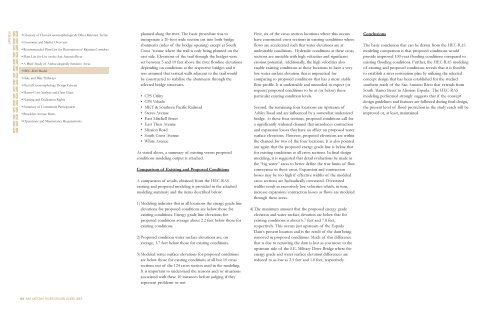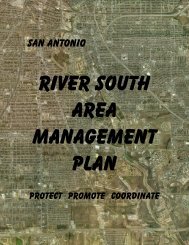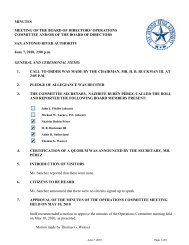concept design san antonio river improvements project
concept design san antonio river improvements project
concept design san antonio river improvements project
You also want an ePaper? Increase the reach of your titles
YUMPU automatically turns print PDFs into web optimized ePapers that Google loves.
APPENDIX<br />
• Glossary of Fluvial Geomorphologic & Other Relevant Terms<br />
• Economic and Market Overview<br />
• Recommended Plant List for Restoration of Riparian Corridors<br />
• Plant List for Use on the San Antonio River<br />
• A Brief Study of Archaeologically Sensitive Areas<br />
• HEC-RAS Model<br />
• Hike and Bike Pathways<br />
• Fluvial Geomorphology Design Criteria<br />
• Master Cost Analysis and Gant Chart<br />
• Naming and Dedication Rights<br />
• Summary of Community Participation<br />
• Brooklyn Avenue Dam<br />
• Operations and Maintenance Requirements<br />
118 SAN ANTONIO RIVER DESIGN GUIDELINES<br />
planned along the <strong>river</strong>. The basic procedure was to<br />
incorporate a 20-foot wide section cut into both bridge<br />
abutments (sides of the bridge opening) except at South<br />
Cross Avenue where the trail is only being planned on the<br />
east side. Elevations of the trail through the bridges were<br />
set between 5 and 10 feet above the <strong>river</strong> flowline elevations<br />
depending on conditions at the respective bridges and it<br />
was assumed that vertical walls adjacent to the trail would<br />
be constructed to stabilize the abutments through the<br />
selected bridge structures.<br />
• CPS Utility<br />
• CPS Vehicle<br />
• MKT & Southern Pacific Railroad<br />
• Steves Avenue<br />
• East Mitchell Street<br />
• East Theo Avenue<br />
• Mission Road<br />
• South Cross Avenue<br />
• White Avenue<br />
As stated above, a summary of existing versus proposed<br />
conditions modeling output is attached.<br />
Comparison of Existing and Proposed Conditions<br />
A comparison of results obtained from the HEC-RAS<br />
existing and proposed modeling is provided in the attached<br />
modeling summary and the items described below:<br />
1) Modeling indicates that in all locations the energy grade line<br />
elevations for proposed conditions are below those for<br />
existing conditions. Energy grade line elevations for<br />
proposed conditions average about 2.2 feet below those for<br />
existing conditions.<br />
2) Proposed condition water surface elevations are, on<br />
average, 1.7 feet below those for existing conditions.<br />
3) Modeled water surface elevations for proposed conditions<br />
are below those for existing conditions at all but 10 cross<br />
sections out of the 124 cross section used in the modeling.<br />
It is important to understand the reasons and/or situations<br />
associated with these 10 instances before judging if they<br />
represent problems or not.<br />
First, six of the cross section locations where this occurs<br />
have constricted cross sections in existing conditions where<br />
flows are accelerated such that water elevations are at<br />
undesirable conditions. Hydraulic conditions at these cross<br />
sections are unstable with high velocities and significant<br />
erosion potential. Additionally, the high velocities also<br />
enable existing conditions at these locations to have a very<br />
low water surface elevation that is impractical for<br />
comparing to proposed conditions that has a more stable<br />
flow profile. It is undesirable and unneeded to expect (or<br />
require) proposed conditions to be at (or below) these<br />
particular existing condition levels.<br />
Second, the remaining four locations are upstream of<br />
Ashley Road and are influenced by a somewhat undersized<br />
bridge. At these four sections, proposed conditions call for<br />
a significantly widened channel that introduces contraction<br />
and expansion losses that have an affect on proposed water<br />
surface elevations. However, proposed elevations are within<br />
the channel for two of the four locations. It is also pointed<br />
out again that the proposed energy grade line is below that<br />
for existing conditions at all cross sections. In final <strong>design</strong><br />
modeling, it is suggested that detail evaluations be made in<br />
the “big water” areas to better define the true limits of flow<br />
conveyance in these areas. Expansion and contraction<br />
losses may be too high if effective widths of the modeled<br />
cross sections are hydraulically overstated. Overstated<br />
widths result in excessively low velocities which, in turn,<br />
increase expansion/contraction losses as flows are modeled<br />
through these areas.<br />
4) The maximum amount that the proposed energy grade<br />
elevation and water surface elevation are below that for<br />
existing conditions is about 6.7 feet and 7.8 feet,<br />
respectively. This occurs just upstream of the Espada<br />
Dam’s present location and is the result of the dam being<br />
removed in proposed conditions. Much of this difference<br />
that is due to removing the dam is lost as you move to the<br />
upstream side of the S.E. Military Drive Bridge where the<br />
energy grade and water surface elevation differences are<br />
reduced to as low as 2.5 feet and 1.0 feet, respectively.<br />
Conclusions<br />
The basic conclusion that can be drawn from the HEC-RAS<br />
modeling comparison is that proposed conditions would<br />
provide improved 100-year flooding conditions compared to<br />
existing flooding conditions. Further, the HEC-RAS modeling<br />
of existing and proposed conditions reveals that it is feasible<br />
to establish a <strong>river</strong> restoration plan by utilizing the selected<br />
<strong>concept</strong> <strong>design</strong> that has been established for the studied<br />
southern reach of the San Antonio River that extends from<br />
South Alamo Street to Mission Espada. The HEC-RAS<br />
modeling performed strongly suggests that if the <strong>concept</strong><br />
<strong>design</strong> guidelines and features are followed during final <strong>design</strong>,<br />
the present level of flood protection in the study reach will be<br />
improved or, at least, maintained.






